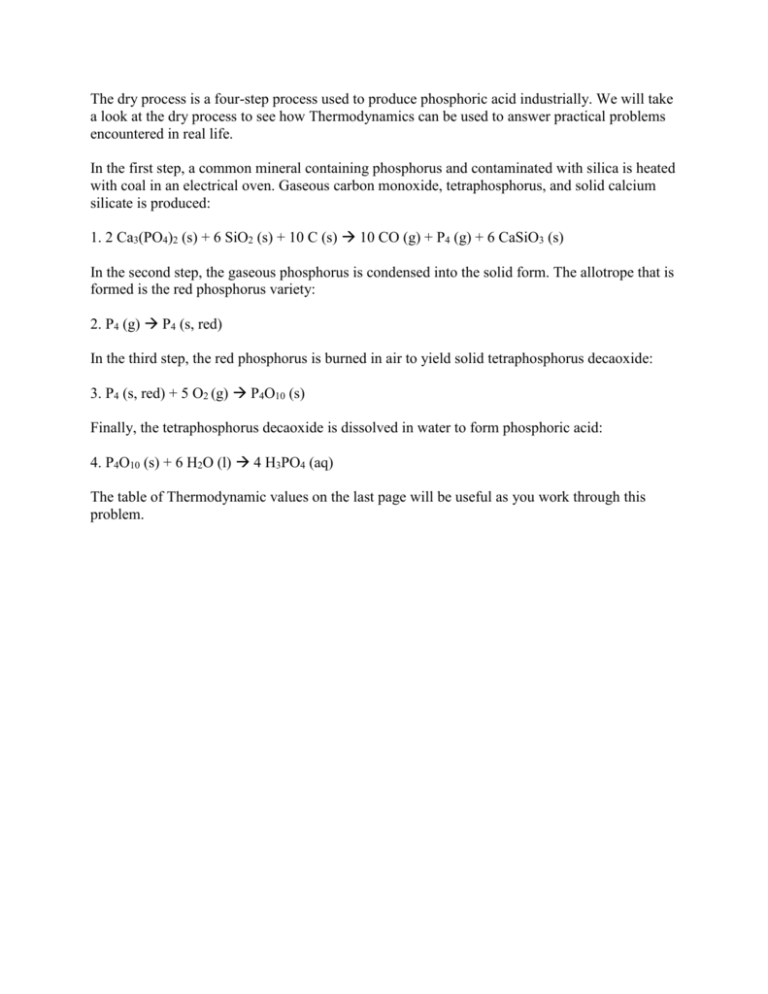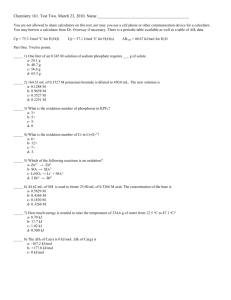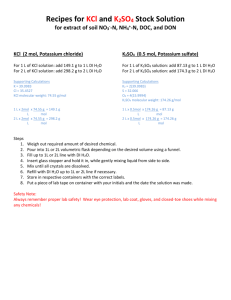The dry process is one way of producing phosphoric acid industrially
advertisement

The dry process is a four-step process used to produce phosphoric acid industrially. We will take a look at the dry process to see how Thermodynamics can be used to answer practical problems encountered in real life. In the first step, a common mineral containing phosphorus and contaminated with silica is heated with coal in an electrical oven. Gaseous carbon monoxide, tetraphosphorus, and solid calcium silicate is produced: 1. 2 Ca3(PO4)2 (s) + 6 SiO2 (s) + 10 C (s) 10 CO (g) + P4 (g) + 6 CaSiO3 (s) In the second step, the gaseous phosphorus is condensed into the solid form. The allotrope that is formed is the red phosphorus variety: 2. P4 (g) P4 (s, red) In the third step, the red phosphorus is burned in air to yield solid tetraphosphorus decaoxide: 3. P4 (s, red) + 5 O2 (g) P4O10 (s) Finally, the tetraphosphorus decaoxide is dissolved in water to form phosphoric acid: 4. P4O10 (s) + 6 H2O (l) 4 H3PO4 (aq) The table of Thermodynamic values on the last page will be useful as you work through this problem. Part 1: Is step 1 product-favored or reactant-favored at 25 C? If it is reactant-favored, at what temperature will it become product-favored (assuming there are no phase changes in reactants or products or that the H or S’s do not otherwise change)? Solution: H = 10 (-110.525 kJ) + 1 (58.91 kJ) + 6 (-1634.9 kJ) – 2 (-4121 kJ) – 6 (-910.94 kJ) = 2851.9 kJ S = 10 (197.674 J/K) + (279.9 J/K) + 6 (81.92 J/K) – 2 (236 J/K) – 6 (41.84 J/K) – 10 (5.740 J/K) = 1967.72 J/K G = H - TS At 25 C (298.15 K) G = 2851.9 kJ – 298.15 K ·1967.72 J/K · 1 kJ/1000 J = 2262.5 kJ reactant-favored at 25 C G = H - TS < 0 2851.9 kJ – T·(1967.72 J/K ·1 kJ/1000 J) < 0 -1.96772T kJ/K < -2851.9 kJ T > 2851.9 kJ/(1.96772 kJ/K) T > 1450 K = 1180 C Part 2: How much water is required to dissipate the heat released when the phosphorus is condensed from the gas phase at 1180 C to the solid state at 25 C? At 43 atm, red phosphorus sublimes to gaseous tetraphosphorus at 590 C. In your calculation, neglect the heat of sublimation since it is relatively small compared to the heat needed to change the temperature of the phosphorus. Assume that the water comes into the plant at 25 C and is discharged at 30 C. Express your answer in gallons of water per mole of P4 condensed c (P4(g)) = 67.15 J/mol·K c (P4(s,red)) = 28.84 J/mol·K c (H2O(l)) = 4.184 J/g · K 1 g H2O = 1 mL H2O 1 L = 1.056710 qt 4 qt = 1 gal Part a: Calculate the heat released by the phosphorus: q = mcT (gas) + mcT (solid) = (67.15 J/mol·K (590 – 1180) K + 28.84 J/mol·K (25 – 590) K) · 1 kJ/1000 J = -52 kJ/mol Part b: Calculate the amount of water required to absorb and dissipate that much heat: 52 kJ/mol P4 · 1mol/123.8952 g · 1000 g/1 kg · 1/(4.184 J/g H2O K · 5 K) · 1000 J/kJ · 1 mL/1 g · 1L/1000 mL · 1.056710 qt/1L · 1 gal/4 qt = 5.30 gal H2O/kg P4 condensed Part 3: Use the Gf values listed in the table to find the G for the overall process, the sum of steps 2-4. If these steps could be coupled to the reactant-favored first step, would the overall process be product-favored? Solution: Step 2: G = Gf (P4(s, red)) - Gf (P4(g)) = -48.4 kJ – 24.48 kJ = -72.88 kJ Step 3: G = Gf (P4O10(s)) - Gf (P4(s, red)) – 5 Gf (O2(g)) = -2697.7 kJ – (-48.4 kJ) – 5 (0) = -2649.3 kJ Step 4: G = 4 Gf (H3PO4(aq)) - Gf (P4O10(s)) – 6 Gf (H2O(l)) = 4 (-1019 kJ) – (-2697.7 kJ) – 6 (-237.129 kJ) = 44.474 kJ Overall (2-4) G = -72.88 kJ + -2649.3 kJ + 44.474 kJ = -2677.706 kJ Overall G = 2262.5 kJ – 2677.706 kJ = -415.2 kJ Therefore, the overall dry process is product-favored, and would proceed without the input of energy if reactions 2-4 could be coupled to reaction 1. In reality, this would be difficult to do. I can’t think of any way to couple the condensation of tetraphosphorus to reaction 1. It may be possible to generate some electricity from the burning of tetraphosphorus in reaction 3 by boiling water to turn a turbine. Step 4 is reactant-favored according to these calculations (which doesn’t make much sense to me). Burning the carbon monoxide produced in step 1 may be another way to make the overall process product-favored, but that free energy change is not accounted for in these calculations. Some Thermodynamic Values (298.15 K) Species Ca3(PO4)2 (s) CaSiO3 (s) C (s, graphite) CO (g) H2O (l) O2 (g) P4 (s, red) P4 (g) P4O10 (s) H3PO4 (aq) SiO2 (s) Hfº (kJ/mol) -4121 -1634.9 0 -110.525 -285.830 0 -70.4 58.91 -2984.0 -1277 -910.94 Sº (J/mol·K) 236 81.92 5.740 197.674 69.91 205.138 91.2 279.9 228.86 -220 41.84 Heat capacity of P4 (g) = 67.15 J/mol·K Heat capacity of P4 (s, red) = 28.84 J/ J/mol·K Sublimation point of P4 (s, red) = 590 °C Heat capacity of H2O (l) = 4.184 J/mol·K 1 g H2O = 1 mL H2O 1 L = 1.056710 qt 4 qt = 1 gal Gfº (kJ/mol) -3885 -1549.7 0 -137.168 -237.129 0 -48.4 24.48 -2697.7 -1019 -856.64








